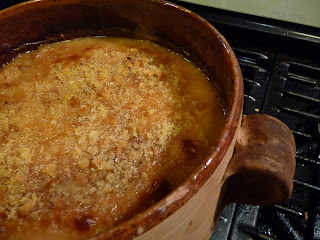You may remember that about six months ago, my friend, Joseph, and I put together a batch of duck confit, with the hopes of preparing a cassoulet that could compete with the best Toulouse had to offer.
Well, we did just that a few weeks ago.
Joseph and I were going back and forth regarding what recipe to use, because this is in no way a prepare-off-the-top-of-your-head kind of dish.
Not at all. It requires research.
I'd made cassoulet twice before, using a solid recipe from Gourmet. The Canal House Cooking recipes intrigued us, but in the end we wanted to try something a little more traditional.
When Joseph forwarded a recipe from Food & Wine that indicated the cooking was to be accomplished over four days, I thought that he was more than a little bit crazy. As if anyone, has time to prepare a four day recipe, let alone the mother of a toddler.
Yes, I was skeptical.
After a number of attempts at reading through the lengthy recipe, I realized that it was an adaptation of a Paula Wolfert recipe from The Cooking of Southwest France (fantastic cookbook -- just ask Jonathan Gold). Of course, a Paula Wolfert recipe would take four days -- she is the grand dame of slow cooking.
I decided to climb on board.
Big props to Joseph for his enthusiasm and willingness to take on a seemingly ridiculous project. Never in a million years would I have chosen to do this on my own. But in the afterglow of this project, I am so glad that we did.
Having chosen the recipe, the flurry of shopping began.
Where do you find pig skin?
What about Tarbais beans? Scratch those -- too hard to find -- we'll settle for cannellini.
Fe and I headed out to the Farmer's Market at Third and Fairfax, and hit up Monsieur Marcel, Huntington Meats, and Marconda Meats.
I hardly ever make it to Monsieur Marcel, but I dig it there. They had the Piment D'Espelette that I had been searching for. And even at $27 for a tiny jar, I figured it was my lucky day. They also had all the pancetta, prosciutto, Toulouse sausages, and cannellini beans that my heart could desire, so we were very well on our way.
Huntington had the ham hocks, and pork shoulder, and Marconda had the salt pork. The Grove graciously provided all the twinkling lights and water fountains that Fe could hope for, so it really turned out to be a perfect outing.
The other shocking aspect of this cassoulet recipe -- besides the time factor -- is the sheer amount of meat required. Not only would we be using our duck confit, we would be adding pork skin, pork shoulder, salt pork, prosciutto, pancetta, Toulouse sausages, two ham hocks, and duck fat.
Honestly, I felt mildly horrified by it all. Although strangely, when we were enjoying the final results, I quipped that the dish actually seemed innocent. The meat had all fallen apart. The fat had melted. You could barely tell how much artery-clogging-delight you were consuming.


So I began on a Tuesday night. The beans needed soaking, and the pork shoulder needed to be cubed. The shoulder, skin, and hocks were placed in a bowl and seasoned lightly with salt and pepper, and then tucked away into the refrigerator to spend the night.

That was simple enough. Except for the fact that I screwed it up. Fresh ham hocks. I glossed over that little word, fresh. What we had ready to go on Wednesday were smoked ham hocks.
Not really the same thing.
I had a minor panic attack. If it were just me -- no big deal. But I was letting Joseph down. I'm not used to cooking with other people. It adds a whole new level of responsibility!
Racked with guilt, I made some phone calls. My former beau and knower of all things food talked me off the ledge. He convinced me that there were certainly folks living in the French countryside whose secret ingredient to exquisite cassoulet were ham hocks that were specifically and particularly smoked.
Phew. I believed him. And yes, it was definitely okay.



The next night, Wednesday, was a big night of cooking, involving simmering salt pork and pig skin, tying up skin bundles, melting duck fat, browning all manner of pork, and lots more simmering of the resulting pork ragout. An hour and a half's worth.



By the time the first simmer was completed, the clock was slipping past 9 p.m. Rita had seen to our hunger by bringing over food from the outstanding Pollo a la Brasa (lips burning from green sauce). Yet there was still an additional two hours of simmering to go, once the beans were added.
Staying up late was the only option. The beans finished cooking and cooling and much past my bedtime, I was asleep.

This recipe requires commitment. Joseph was back at my house by 8:40 the next morning.
The recipe instructs you to remove as much solidified fat from the surface of the pot. We didn't find an obvious layer of fat to chip away at. I think it may have seeped into the cannellini beans.
The slabs of prosciutto and pancetta that were browned the previous day and simmered in the ragout are to be plucked out and cut into bite-size pieces. The meat should be removed from the hocks. So much of the meat had already shredded itself during the simmering that this process was rather quick and easy -- not to mention that Joseph was the one doing it.

Strangely our bouquet garni had vanished entirely. The celery ribs were nowhere to be found! Mysterious. There had been a whole head of garlic that simmered away in our ragout, and those cloves were to be squeezed out to purée with the salt pork and raw garlic. Impossible. The garlic had completely worked its way out of its wrapping all on its own.


I did purée the raw garlic with the salt pork. We added that to the ragout and simmered for 15 minutes longer.
We had to taste. The excitement began to build. The dish was already pretty damn amazing and we had four major steps in the recipe to complete, including adding the duck confit and Toulouse sausages. It felt like we might have a real winner on our hands.

That was Thursday morning. Amusingly, we had finally finished the do ahead part -- only took three days! -- of the cassoulet recipe. We were free until Saturday afternoon!
Saturday night was designated as the cassoulet orgy, so Joseph and I got busy again on Saturday afternoon. The duck confit had to be retrieved from its hiding space, buried deep within a jar of duck fat and far back in the depths of my refrigerator. It had been quietly resting there for about six months.


The confit was heated through, removed from the bones, and then shredded. Those funny looking pork bundles were untied, and placed on the bottom of an old french earthenware casserole that I dusted off for the occasion.


The confit and the bean ragout were layered and the remaining broth was added to the cooking liquid.
Wait a minute. Here we had questions that were not obviously answered by the recipe.

Just how liquidy should the ragout have been? Ours was not liquidy at all. We added a bit of additional stock to make up for this, but then were left second guessing ourselves in the final stages of the recipe. Was the cassoulet too wet and did we need to cook it longer to reduce some of the liquid?

My only real complaint about the recipe is that it is almost punishingly long and detailed, but does not provide enough detail as to what your results should be throughout the journey. For such a commitment to the recipe on our part, I wanted the recipe to hold our hand a little bit more along the way.
But back to the process. At this point, because there was not quite enough animal fat in the cassoulet you add about two more tablespoons of melted duck fat. You know, just to be safe.
The cassoulet is then baked for an hour and a half. During that time the Toulouse sausages need to be browned in a little bit more oil, and cut into pieces, ready to be mixed in.

After the initial hour and a half of baking, the sausages are added and -- wait for it -- two more tablespoons of melted duck fat are stirred into the pot. The top is dusted with bread crumbs and the whole shebang is baked at a reduced temperature for just one more hour. After that the precious mix only needs to recover quietly on a cloth-lined rack for twenty minutes, before you can finally sup.

Writing this, I am struck by how insane the whole process was; how any realistic person would never even consider a recipe such as this. And quite honestly, I believe myself to be heavily based in reality.
But to be frank, this was so much fun. Even though I had trouble even reading through the entire recipe in one sitting, it was a project well worth tackling. Definitely something to do with a pal. And certainly a meal to be shared with deserving friends and family, perhaps even during these chilly winter holidays.


The results were dynamite.
The beans were luscious from absorbing so much pork and duck fat. The consistency seemed right -- not too soupy and not too stiff -- after we added a little extra stock and let it cook for a little extra time. I'm glad we added additional breadcrumbs on top as well. A crisp crust is essential to a great cassoulet. Next time, I would probably try to find a way to work the duck skin into the crumb topping to give it even more crunchy texture and contrast with the soft beans and meat.
On a cool fall evening the cassoulet went superbly with a bracing salad of romaine, rocket and pears, and several bottles of tannic red wine. We were sated, but not crippled by the meal, which to me equals success.
And on a final note, I cannot recommend highly enough making your own duck confit. It was fabulous. We ate the rest of it four nights later. Crisped up in a sauté pan and served with an acidic salad and potatoes roasted in duck fat, we were transported to the French countryside. Stellar.


5 comments:
It was so delicious! What an experience. Thank you. Thank you.
I'm in awe! What a commitment -- and it sounds absolutely delicious.
Bravo to J & J!!
Holy cow!!! This sounds CRAZY!! WHAT A PROCESS!!! Thinking of you and will write soon...I promise ;-).
I have a short version of cassoulet which you should try sometime. It is very good and way less time consuming. You'd have to judge for yourself whether it is as good as what you describe but even if it isn't it is very easy.This recipe does sound excellent and fun to do with at least another person as you so wisely did.
Post a Comment